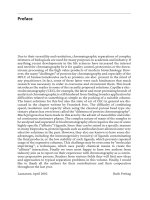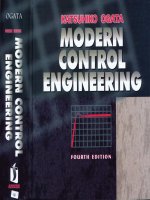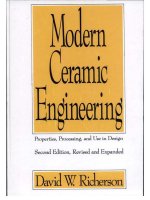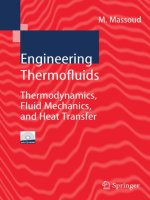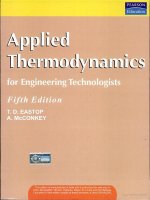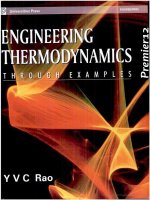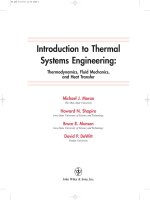Modern engineering thermodynamics
Bạn đang xem bản rút gọn của tài liệu. Xem và tải ngay bản đầy đủ của tài liệu tại đây (7.93 MB, 827 trang )
Modern Engineering
Thermodynamics
This page intentionally left blank
Modern Engineering
Thermodynamics
Robert T. Balmer
AMSTERDAM
•
BOSTON
•
HEIDELBERG
•
LONDON
NEW YORK
•
OXFORD
•
PARIS
•
SAN DIEGO
SAN FRANCISCO
•
SINGAPORE
•
SYDNEY
•
TOKYO
Academic Press is an imprint of Elsevier
Academic Press is an imprint of Elsevier
30 Corporate Drive, Suite 400, Burlington, MA 01803, USA
The Boulevard, Langford Lane, Kidlington, Oxford, OX5 1GB, UK
©
2011 Elsevier Inc. All rights reserved.
No part of this publication may be reproduced or transmitted in any form or by any means, electronic or mechanical,
including photocopying, recording, or any information storage and retrieval system, without permission in writing
from the publisher. Details on how to seek permission, further information about the Publisher’s permissions policies
and our arrangements with organizations such as the Copyright Clearance Center and the Copyright Licensing Agency,
can be found at our website: www.elsevier.com/permissions.
This book and the individual contributions contained in it are protected under copyright by the Publisher (other than
as may be noted herein).
Notices
Knowledge and best practice in this field are constantly changing. As new research and experience broaden our
understanding, changes in research methods, professional practices, or medical treatment may become necessary.
Practitioners and researchers must always rely on their own experience and knowledge in evaluating and using any
information, methods, compounds, or experiments described herein. In using such information or methods they
should be mindful of their own safety and the safety of others, including parties for whom they have a professional
responsibility.
To the fullest extent of the law, neither the Publisher nor the authors, contributors, or editors, assume any liability for
any injury and/or damage to persons or property as a matter of products liability, negligence or otherwise, or from any
use or operation of any methods, products, instructions, or ideas contained in the material herein.
Library of Congress Cataloging-in-Publication Data
Balmer, Robert T.
Modern engineering thermodynamics / Robert T. Balmer
p. cm.
ISBN 978-0-12-374996-3
1. Thermodynamics. I. Title.
TJ265.B196 2010
621.402'1–dc22 2010034092
British Library Cataloguing-in-Publication Data
A catalogue record for this book is available from the British Library.
For information on all Academic Press publications,
visit our website: www.elsevierdirect.com
Typeset by: diacriTech, India
Printed in the United States of America
10 11 12 13 6 5 4 3 2 1
Dedication
WHAT IS AN ENGINEER AND WHAT DO ENGINEERS DO?
The answer is in the word itself. An er word ending me ans “the practice of.” For example, a farmer farms, a
baker bakes, a singer sings, a driver drives, and so forth. But what does an engineer do? Do they engine? Yes they
do! The word engine comes from the Latin ingenerare, meaning “to create.“
About 2000 years ago, the Latin word ingenium was used to describe the design of a new machine. Soon after,
the word ingen was being used to describe all machines. In English, “ingen” was spelled “engine” and people
who designed creativ e things were known as “engine-ers”. In French, German, and Spanish today, the word for
engineer is ingenieur.
So What Is an Engineer?
An engineer is a creative and ingenious person.
What Does an Engineer Do?
Engineers create ingenious solutions to society’s problems.
This Book Is Dedicated to All the Future Engineers of the World.
v
This page intentionally left blank
Contents
PREFACE . . . . . . . . . . . . . . . . . . . . . . . . . . . . . . . . . . . . . . . . . . . . . . . . . . . . . . . . . . . . . . . . . . . . . . . xiii
ACKNOWLEDGMENTS . . . . . . . . . . . . . . . . . . . . . . . . . . . . . . . . . . . . . . . . . . . . . . . . . . . . . . . . . . . . xvii
RESOURCES THAT ACCOMPANY THIS BOOK . . . . . . . . . . . . . . . . . . . . . . . . . . . . . . . . . . . . . . . . . . xix
LIST OF SYMBOLS. . . . . . . . . . . . . . . . . . . . . . . . . . . . . . . . . . . . . . . . . . . . . . . . . . . . . . . . . . . . . . . . xxi
PROLOGUE . . . . . . . . . . . . . . . . . . . . . . . . . . . . . . . . . . . . . . . . . . . . . . . . . . . . . . . . . . . . . . . . . . . . xxiii
CHAPTER 1 The Beginning . . . . . . . . . . . . . . . . . . . . . . . . . . . . . . . . . . . . . . . . . . . . . . . . . . . . . . . . 1
1.1 What Is Thermodynamics? 1
1.2 Why Is Thermodynamics Important Today?. . . 2
1.3 Getting Answers: A Basic Problem Solving Technique 4
1.4 Units and Dimensions . . 6
1.5 How Do We Measure Things? . . 6
1.6 Temperature Units 8
1.7 Classical Mechanical and Electrical Units Systems . . 10
1.8 Chemical Units. . 14
1.9 Modern Units Systems . . 15
1.10 Significant Figures 17
1.11 Potential and Kinetic Energies . . 20
Summary 25
CHAPTER 2 Thermodynamic Concepts . . . . . . . . . . . . . . . . . . . . . . . . . . . . . . . . . . . . . . . . . . . . . . 33
2.1 Introduction 33
2.2 The Language of Thermodynamics . . . 34
2.3 Phases of Matter 35
2.4 System States and Thermodynamic Properties 36
2.5 Thermodynamic Equilibrium . . . 38
2.6 Thermodynamic Processes 39
2.7 Pressure and Temperature Scales 40
2.8 The Zeroth Law of Thermodynamics . . 42
2.9 The Continuum Hypothesis 43
2.10 The Balance Concept . . . 44
2.11 The Conservation Concept 46
2.12 Conservation of Mass. . . 50
Summary 51
CHAPTER 3 Thermodynamic Properties. . . . . . . . . . . . . . . . . . . . . . . . . . . . . . . . . . . . . . . . . . . . . . 57
3.1 The Trees and The Forest 57
3.2 Why are Thermodynamic Property Values Important? 58
3.3 Fun with Mathematics . . 58
3.4 Some Exciting New Thermodynamic Properties 60
3.5 System Energy. . 62
3.6 Enthalpy. . 63
3.7 Phase Diagrams . 65
3.8 Quality . . . 72
vii
3.9 Thermodynamic Equations of State 76
3.10 Thermodynamic Tables . . . 84
3.11 How Do You Determine the “Thermodynamic State”? 86
3.12 Thermodynamic Charts . . . 87
3.13 Thermodynamic Property Software 89
Summary . 90
CHAPTER 4 The First Law of Thermodynamics and Energy Transport Mechanisms . . . . . . . . . . . 99
4.1 Introducción (Introduction). 100
4.2 Emmy Noether and the Conservation Laws of Physics . 100
4.3 The First Law of Thermodynamics 101
4.4 Energy Transport Mechanisms . . . 104
4.5 Point and Path Functions . . 107
4.6 Mechanical Work Modes of Energy Transport . . . 108
4.7 Nonmechanical Work Modes of Energy Transport 116
4.8 Power Modes of Energy Transport. 124
4.9 Work Efficiency . . . 124
4.10 The Local Equilibrium Postulate . . 126
4.11 The State Postulate 127
4.12 Heat Modes of Energy Transport . . 127
4.13 Heat Transfer Modes 128
4.14 A Thermodynamic Problem Solving Technique . . 130
4.15 How to Write a Thermodynamics Problem 134
Summary . 138
CHAPTER 5 First Law Closed System Applications . . . . . . . . . . . . . . . . . . . . . . . . . . . . . . . . . . . . 147
5.1 Introduction . . 147
5.2 Sealed, Rigid Containers . . . 148
5.3 Electrical Devices. . . 150
5.4 Power Plants . 151
5.5 Incompressible Liquids 152
5.6 Ideal Gases . . 154
5.7 Piston-Cylinder Devices 155
5.8 Closed System Unsteady State Processes . 157
5.9 The Explosive Energy of Pressure Vessels 159
Summary . 160
CHAPTER 6 First Law Open System Applications . . . . . . . . . . . . . . . . . . . . . . . . . . . . . . . . . . . . . 167
6.1 Introduction . 167
6.2 Mass Flow Energy Transport 168
6.3 Conservation of Energy and Conservation of Mass Equations for Open Systems . . . 171
6.4 Flow Stream Specific Kinetic and Potential Energies . . . 173
6.5 Nozzles and Diffusers. 174
6.6 Throttling Devices . 179
6.7 Throttling Calorimeter 182
6.8 Heat Exchangers . . 184
6.9 Shaft Work Machines 187
6.10 Open System Unsteady State Processes . 190
Summary . 197
CHAPTER 7 Second Law of Thermodynamics and Entropy Transport
andProductionMechanisms 205
7.1 Introduction . 205
7.2 What Is Entropy? . . 206
7.3 The Second Law of Thermodynamics . . . 207
7.4 Carnot’s Heat Engine and the Second Law of Thermodynamics 208
7.5 The Absolute Temperature Scale . . 212
viii Contents
7.6 Heat Engines Running Backward 216
7.7 Clausius’s Definition of Entropy. 218
7.8 Numerical Values for Entropy . . 221
7.9 Entropy Transport Mechanisms . 227
7.10 Differential Entropy Balance . . . 227
7.11 Heat Transport of Entropy 229
7.12 Work Mode Transport of Entropy 231
7.13 Entropy Production Mechanisms 231
7.14 Heat Transfer Production of Entropy . . 232
7.15 Work Mode Production of Entropy 235
7.16 Phase Change Entropy Production 239
7.17 Entropy Balance and Entropy Rate Balance Equations 240
Summary 241
CHAPTER 8 Second Law Closed System Applications . . . . . . . . . . . . . . . . . . . . . . . . . . . . . . . . . . 249
8.1 Introduction 249
8.2 Systems Undergoing Reversible Processes 250
8.3 Systems Undergoing Irreversible Processes 256
8.4 Diffusional Mixing 271
Summary 273
CHAPTER 9 Second Law Open System Applications . . . . . . . . . . . . . . . . . . . . . . . . . . . . . . . . . . . 279
9.1 Introduction 279
9.2 Mass Flow Transport of Entropy . 279
9.3 Mass Flow Production of Entropy 280
9.4 Open System Entropy Balance Equations 280
9.5 Nozzles, Diffusers, and Throttles . 284
9.6 Heat Exchangers . 289
9.7 Mixing 293
9.8 Shaft Work Machines 296
9.9 Unsteady State Processes in Open Systems 297
Summary 308
Final Comments on the Second Law . 310
CHAPTER 10 Availability Analysis. . . . . . . . . . . . . . . . . . . . . . . . . . . . . . . . . . . . . . . . . . . . . . . . . . 319
10.1 What Is Availability? . . 319
10.2 Fun with Scalar, Vector, and Conservative Fields . . 320
10.3 What are Conservative Forces? 321
10.4 Maximum Reversible Work . . . 322
10.5 Local Environment 322
10.6 Availability 323
10.7 Closed System Availability Balance . . 327
10.8 Flow Availability 331
10.9 Open System Availability Rate Balance 334
10.10 Modified Availability Rate Balance Equation . 335
10.11 Energy Efficiency Based on the Second Law . 339
Summary 351
CHAPTER 11 More Thermodynamic Relations. . . . . . . . . . . . . . . . . . . . . . . . . . . . . . . . . . . . . . . . . 361
11.1 Kynning (Introduction) . 361
11.2 Two New Properties: Helmholtz and Gibbs Functions 362
11.3 Gibbs Phase Equilibrium Condition . . 366
11.4 Maxwell Equations 367
11.5 The Clapeyron Equation. 370
11.6 Determining u, h, and s from p, v, and T 372
11.7 Constructing Tables and Charts 378
11.8 Thermodynamic Charts 380
Contents ix
11.9 Gas Tables . 382
11.10 Compressibility Factor and Generalized Charts . 384
11.11 Is Steam Ever an Ideal Gas? 396
Summary . 398
CHAPTER 12 Mixtures of Gases and Vapors . . . . . . . . . . . . . . . . . . . . . . . . . . . . . . . . . . . . . . . . . . 405
12.1 Wprowadzenie (Introduction) 405
12.2 Thermodynamic Properties of Gas Mixtures 406
12.3 Mixtures of Ideal Gases . . . 412
12.4 Psychrometrics 417
12.5 The Adiabatic Saturator . . . 420
12.6 The Sling Psychrometer . . . 421
12.7 Air Conditioning . . 424
12.8 Psychrometric Enthalpies. . 426
12.9 Mixtures of Real Gases . . . 430
Summary . 438
CHAPTER 13 Vapor and Gas Power Cycles . . . . . . . . . . . . . . . . . . . . . . . . . . . . . . . . . . . . . . . . . . . 447
13.1 Bevezetésének (Introduction) 448
13.2 Part I. Engines and Vapor Power Cycles 448
13.3 Carnot Power Cycle 456
13.4 Rankine Cycle . . . 457
13.5 Operating Efficiencies . . . 459
13.6 Rankine Cycle with Superheat . . . 466
13.7 Rankine Cycle with Regeneration 469
13.8 The Development of the Steam Turbine. 474
13.9 Rankine Cycle with Reheat 477
13.10 Modern Steam Power Plants 480
13.11 Part II. Gas Power Cycles. 486
13.12 Air Standard Power Cycles. 486
13.13 Stirling Cycle 488
13.14 Ericsson Cycle . . . 490
13.15 Lenoir Cycle 493
13.16 Brayton Cycle 495
13.17 Aircraft Gas Turbine Engines 499
13.18 Otto Cycle . 502
13.19 Atkinson Cycle . . . 508
13.20 Miller Cycle 509
13.21 Diesel Cycle 512
13.22 Modern Prime Mover Developments . . . 516
13.23 Second Law Analysis of Vapor and Gas Power Cycles. . . . . . . . . . . . . . . . . . . . . . . . . .518
Summary . 525
CHAPTER 14 Vapor and Gas Refrigeration Cycles. . . . . . . . . . . . . . . . . . . . . . . . . . . . . . . . . . . . . . 535
14.1 Introduksjon (Introduction) 535
14.2 Part I. Vapor Refrigeration Cycles 536
14.3 Carnot Refrigeration Cycle 537
14.4 In the Beginning There Was Ice. . 539
14.5 Vapor-Compression Refrigeration Cycle . 542
14.6 Refrigerants 547
14.7 Refrigerant Numbers 549
14.8 CFCs and the Ozone Layer 552
14.9 Cascade and Multistage Vapor-Compression Systems . 554
14.10 Absorption Refrigeration . 560
14.11 Commercial and Household Refrigerators 562
14.12 Part II. Gas Refrigeration Cycles . 568
x Contents
14.13 Air Standard Gas Refrigeration Cycles 568
14.14 Reversed Brayton Cycle Refrigeration 569
14.15 Reversed Stirling Cycle Refrigeration . 572
14.16 Miscellaneous Refrigeration Technologies . . . 575
14.17 Future Refrigeration Needs . . . 578
14.18 Second Law Analysis of Refrigeration Cycles. 579
Summary 582
CHAPTER 15 Chemical Thermodynamics . . . . . . . . . . . . . . . . . . . . . . . . . . . . . . . . . . . . . . . . . . . . 591
15.1 Einführung (Introduction) 591
15.2 Stoichiometric Equations 593
15.3 Organic Fuels. . 596
15.4 Fuel Modeling . 599
15.5 Standard Reference State 603
15.6 Heat of Formation 604
15.7 Heat of Reaction 607
15.8 Adiabatic Flame Temperature . 613
15.9 Maximum Explosion Pressure . 619
15.10 Entropy Production in Chemical Reactions. . . 621
15.11 Entropy of Formation and Gibbs Function of Formation. . . . 625
15.12 Chemical Equilibrium and Dissociation 626
15.13 Rules for Chemical Equilibrium Constants . . . 634
15.14 The van’t Hoff Equation 635
15.15 Fuel Cells 636
15.16 Chemical Availability . . 641
Summary 642
CHAPTER 16 Compressible Fluid Flow . . . . . . . . . . . . . . . . . . . . . . . . . . . . . . . . . . . . . . . . . . . . . . 651
16.1 Introducerea (Introduction) 651
16.2 Stagnation Properties . . 652
16.3 Isentropic Stagnation Properties 653
16.4 The Mach Number 655
16.5 Converging-Diverging Flows . . 660
16.6 Choked Flow . . 665
16.7 Reynolds Transport Theorem . . 669
16.8 Linear Momentum Rate Balance 673
16.9 Shock Waves . . 675
16.10 Nozzle and Diffuser Efficiencies 681
Summary 685
CHAPTER 17 Thermodynamics of Biological Systems . . . . . . . . . . . . . . . . . . . . . . . . . . . . . . . . . . . 693
17.1 Introdução (Introduction) 693
17.2 Living Systems. . 693
17.3 Thermodynamics of Biological Cells. . . 695
17.4 Energy Conversion Efficiency of Biological Systems . 699
17.5 Metabolism 702
17.6 Thermodynamics of Nutrition and Exercise . . . 705
17.7 Limits to Biological Growth 711
17.8 Locomotion Transport Number . 714
17.9 Thermodynamics of Aging and Death . 716
Summary 721
CHAPTER 18 Introduction to Statistical Thermodynamics . . . . . . . . . . . . . . . . . . . . . . . . . . . . . . . . 727
18.1 Introduction . . . 727
18.2 Why Use a Statistical Approach? 728
18.3 Kinetic Theory of Gases 728
18.4 Intermolecular Collisions 732
Contents xi
18.5 Molecular Velocity Distributions. . 734
18.6 Equipartition of Energy . . 738
18.7 Introduction to Mathematical Probability 741
18.8 Quantum Statistical Thermodynamics . . 747
18.9 Three Classical Quantum Statistical Models . . . 749
18.10 Maxwell-Boltzmann Gases 750
18.11 Monatomic Maxwell-Boltzmann Gases. . 751
18.12 Diatomic Maxwell-Boltzmann Gases . . . 753
18.13 Polyatomic Maxwell-Boltzmann Gases . . 756
Summary . 758
CHAPTER 19 Introduction to Coupled Phenomena . . . . . . . . . . . . . . . . . . . . . . . . . . . . . . . . . . . . . 763
19.1 Introduction . 763
19.2 Coupled Phenomena 763
19.3 Linear Phenomenological Equations 765
19.4 Thermoelectric Coupling . . 767
19.5 Thermomechanical Coupling 776
Summary . 783
APPENDIX A Physical Constants and Conversion Factors . . . . . . . . . . . . . . . . . . . . . . . . . . . . . . . . 787
APPENDIX B Greek and Latin Origins of Engineering Terms . . . . . . . . . . . . . . . . . . . . . . . . . . . . . 789
INDEX . . . . . . . . . . . . . . . . . . . . . . . . . . . . . . . . . . . . . . . . . . . . . . . . . . . . . . . . . . . . . . . . . . . . . . . . . 793
xii Contents
Preface
TEXT OBJECTIVES
This textbook has two main objectives. The first is to provide students with a clear p resentation of the
fundamental principles of basic and applied engineering thermodynamics. The second is to help students develop
skills as engineering problem solvers by nurturing the development of their confidence with basic engineering
principles through the use of numerous solved example problems. Problem-solving skills are not necessarily
learnedsimplybyroutinelysolvingmore and more problem s. The understanding of proven problem-solving
strategies and techniques greatly accelerates the development of problem-solving skills. Throughout the text, learn-
ing assessment exercises are included that have proven to be effective in helping students to understand and
develop confidence in their ability to solve engineering thermodynamics problems.
To meet these objectives, explanations are occasionally more detailed than those found in other texts, because
common learning difficulties encountered by students have been anticipated. If students can understand the text
by simply reading it, then the instructor has more flexibility in selecting lecture material. For example, an
instructor might choose to develop a few salient points from the reading and then work a few interesting
example problems, rather than present a complete derivation of all the assigned reading material.
CULTURAL INFRASTRUCTURE
What engineers do has an enormous impact on society and the world. Understanding how the great challenge s
of engineering were met in the past can help students understand the importance of the theory and practice of
modern engineering principles. This text presents the historical background, the current uses, and the future
importance of the thermodynamic topics treated. By understanding where ideas come from, how they were
developed, and what external forces shaped the resulting technology, students will better understand their role
as engineers of the future.
Engineering is an exciting and rewarding career. However, s tudents occasionally become disenchanted w ith their
engineering course work because t hey are unable to see the connection between what they are studying and
what an engineer really does. To combat this problem, the thermodynamic concepts in this text are presented in
a str aightforward logical manner, and then applied to real-world engineering situations that are both timely and
interesting.
TEXT COVERAGE
This text was designed for use in a standard two-semester engineering thermodynamics course sequence. The first
part of the text (Chapters 1–10) contains material suitable for a Basic Thermodynamics course that can be taken
by engineers from all majors. The second part of the text was designed for an Applied Thermodynamics course
in a m echani cal engineering program. Chapters 17, 18, and 19 present several unique topics (biothermody-
namics, statistical thermodynamics, and co upled phenomena) for those wishing to glimpse the future of the
subject.
xiii
TEXT FEATURES
1. Style. To make the subject as understandable as possible, the writing is somewhat conversational and the
importance of the subject is evidenced in the enthusiasm of the presentation. The composition of the
engineering student body has been changing in recent years, and it is no longer assumed that the students
are all men and that they inherently understand how technologies (e.g., engines) operate. Consequently, the
operation of basic technologies is explained in the text along with the relevant thermodynamic material.
2. Significant figures. One of the unique features of this text is the treatment of significant figures. Professors
often lament about the number of figures provided by students on their homework and examinations. The
rules for determining the correct number of significant figures are introduced in Chapter 1 and are followed
consistently throughout the text. An example from Chapter 1 follows.
EXAMPLE 1.6
The in side diameter of a circular water pipe is measured with a ruler to two significant figures and is found to be 2.5 inches.
Determine the cross-sectional area of the pipe to the correct number of significant figures.
Solution
The cross-sectional area of a circle is A = πD
2
/4, so A
pipe
= π(2.5 inches)
2
/4 = 4.9087 in
2
, which must be rounded to 4.9 in
2
,
since the least accurate value in this calculation is the pipe diameter (2.5 inches), which has only two significant figures.
3. Chapter overviews. Each chapter begins with an overview of the material contained in the chapter.
4. Problem-solving strategy. A proven technique for solving thermodynamic problems is discussed early in the
text and followed throughout in the solved examples. The technique follows these steps:
5. Solved example problems. Over 200 solved example problems are provided in the text. These examples
were carefully designed to illustrate the preceding text material. A sample from Chapter 5 follows.
EXAMPLE P.1
Read the problem statement. An incandescent lightbulb is a simple electrical device. Using the energy rate balance on a
lightbulb, determine the heat transfer rate of a 100. W incandescent lightbulb.
Solution
Step 1. Identify and sketch the system (see Figure P.1 on the following page).
Step 2. Identify the unknowns. The unknown is
_
Q:
Step 3. Identify the type of system. It is a closed system.
Step 4. Identify the proce ss conn ect ing the s ystem st ate s. The bulb does not change its thermodynamic state, so its
properties remain constant. The process path (after the bulb has warmed to its operating temperature) is U = constant.
SUMMARY OF THE THERMODYNAMIC PROBLEM-
SOLVING TECHNIQUE
Begin by carefully reading the problem statement completely through.
Step 1. Make a sketch of the system and put a dashed line around the system boundary.
Step 2. Identify the unknown(s) and write them on your system sketch.
Step 3. Identify the type of system (closed or open) you have.
Step 4. Identify the process that connects the states or stations.
Step 5. Write down the basic thermodynamic equations and any useful auxiliary equations.
Step 6. Algebraically solve for the unknown(s).
Step 7. Calculate the value(s) of the unknown(s).
Step 8. Check all algebra, calculations, and units.
Sketch → Unknowns → System → Process → Equations → Solve → Calculate → Check
xiv Preface
Step 5. Write down the basic equations. The only basic equation thus far
available for a closed system rate process is Eq. (4.21), the general closed
system energy rate balance equation:
_
Q −
_
W =
d
dt
ðmuÞ+
d
dt
mV
2
2g
c
+
d
dt
mgZ
g
c
=
_
U +
_
KE +
_
PE
Assume
_
KE =
_
PE = 0, and since U = constant,
_
U = 0. This reduces the gov-
erning energy rate balance equation for this problem to
_
Q −
_
W = 0:
Write any relevant auxiliary equations. The only relevant auxiliary equation
needed here is that the lightbulb has an electrical work input of 100. W, so
that
_
W = –100. W.
Step 6. Algebraically solve for the unknown(s):
_
Q =
_
W .
Step 7. Calculate the value(s) of the unkn owns:
_
Q =
_
W = –100. W (the
minus sign tells us that the heat is leaving the system).
Step 8. A check of the algebra, calculations, and units shows that they are
correct.
6. Example problem exercises with answers. Immediately following each solved example, several exercises
are provided that are variations on the theme of the solved example. The answers to the exercises are also
provided so that the student can build confidence in problem solving. For example, the exercises for the
preceding example problem might look something like this:
a. What would be the heat transfer rate if the lightbulb in the previous example is replaced by a 20.0 W
fluorescent lightbulb? Answer:
_
Q =
_
W = –20.0 W.
b. How would the lightbulb in the previous example behave if it were put into a small, sealed, rigid,
insulated box? Answer: Since the box is insulated, the heat transfer rate would be zero.
c. How would the internal energy of the incandescent lightbulb change if it were put into a small, sealed,
rigid, insulated box? Answer: Then, since
_
Q = 0,
_
U = −
_
W = 100. W, and the internal energy increases
until the bulb overheats and fails.
7. Unit systems. Engineers today need to understand two types of units systems: classical Engineering English
units and modern metric SI units. Both are used in this text, with SI units used in many of the example and
homework problems.
8. Critical Thinking boxes. At various points in the chapters, special “Critical Thinking” boxes are introduced
to challenge the students’ understanding of the material. The example that follows is from Chapter 3.
9. Question-and-answer boxes. Students’ questions are anticipated at various points throughout the text and
are answered in a simple, direct manner. This example is from Chapter 4.
FIGURE P.1
Example P.1.
CRITICAL THINKING
If we chose the color of a system as a thermodynamic property, would it be an extensive or intensive property?
WHAT ARE HEAT AND WORK?
Heat is usually defined as energy transport to or from a system due to a temperature differen ce between the system and its
surroundings. This can occur by only three modes: conduction, convection, and radiation.
Work is more difficult to define. It is often defined as a force moving through a distance, but this is only one type of work
and there are many othe r work modes as well. Since the only energy transport modes for moving energy across a system’s
boundary are heat, mass flow, and work, the simplest definition of work is that it is as any energy transport mode that is
neither heat nor mass flow.
1
1
Work can also be defined using the concept of a “generalized” force moving through a “generalized” displacement.
Preface xv
10. Case studies in applied thermodynamics. Scattered throughout the text are numerous case studies
describing actual engineering applications of specific thermodynamic concepts. Typical case studies include
the following topics:
Supercritical wastewater treatment; The “drinking bird”; Heat pipes; Vortex tubes; A hypervelocity
gun; GE 90 aircraft engine; Stirling engines; Stanley steamer automobile; Forensic analysis.
11. Historical vignettes. The text also contains numerous short stories describing human side of the
development of important thermodynamic concepts and technologies. The following example is from
Chapter 14.
12. Chapter summaries. Each chapter ends with a summary (including relevant equations) that reviews the
important concepts covered in the chapter.
13. End-of-chapter problems:
■
Homework problems. At the end of each chapter, an extensive set of problems is provided that is
suitable for homework assignments or solved classroom examples. The homework problems include
traditional ones that have only one unique answer, as well as modern computer problems, design
problems, and writing to learn problems that allow students more latitude.
■
The computer problems allow students to use spreadsheets and equation solvers in modern
programming languages to address more complex problems requiring a range of solutions.
■
The design problems provide an opportunity for students to carry out a preliminary design requiring
the use of the material presented in the chapter.
■
Writing to learn problems have a dual function. They allow students to enhance their understanding of
the subject by expressing themselves verbally in short, written essays about topics presented in the
chapter, and they also develop students’ writing and communication skills.
■
Create and solve problems are designed to help students learn how to formulate solvable
thermodynamics problems from engineering data. Engineering education tends to focus only on the
process of solving problems. It ignores teaching the process of formulating solvable problems. However,
working engineers are never given a well-phrased problem statement to solve. Instead, they need to react
to situational information and organize it into a structure that can then be solved using the methods
learned in college.
14. Appendices. There are two appendices in this text. Appendix A provides a list of unit conversions. Since
thermodynamics is laced with a variety of technical terms, some having Greek or Latin origin, Appendix B
provides a brief introduction to the etymology of these terms, in the belief that understanding the meaning of
the words themselves enhances the learning of the subject matter.
15. “Thermodynamic Tables to accompany Modern Engineering Thermodynamics” is included with new copies of this
text. This booklet contains Appendices C and D, tables, and charts essential for solving the text’s
thermodynamics problems.
The United States uses more than 10
17
(100 quadrillion) Btu of energy every year. But the really surprising fact
is that 45% of this energy ends up as waste heat dumped into the lakes, rivers, and atmosphere. Our energy
conversion technologies today are inefficient because we still rely on the burning of fossil fuels. As the 21st century
progresses and more and more countries strive to improve their standard of living, we will need to do a better job
of providing nonthermal ener gy sources. We can and will develop new en ergy-conversion technologies throug h a
detailed understanding and use of the principles of thermodynamics.
IS IT DANGEROUS TO STUFF A CHICKEN WITH SNOW?
The great British philosopher and statesman Sir Francis Bacon (1561 –1626) was keenly interested in the possibility of using
snow to preserve meat. In March 1626, he stopped in the country on a tri p t o London and purchased a chicken. He had the
chickenkilledandcleanedonthespot,thenhepackeditwith snow and took it with him to London. Unfortunately,
the experiment caused his death only a few weeks later. The 65-year-old statesman apparently caught a chill while stuffing
the chicken with snow and came down with terminal bronchitis. Refrigeration was clearly not something to be taken lightly.
xvi Preface
Acknowledgments
I wish to acknowledge help, suggestions, and advice from the following University of Wisconsin–Milwaukee
student reviewers: Thomas Jobs, Christopher Zainer, Janice Fitzgerald, Karen Ali, David Hlavac, Paul Bartelt,
Margaret Mikolajczak, Lisa Lee Winders, Andrew Hensch, Steven Wietrzny, and Brian Polly.
I also wish to acknowledge the assistance of Pr ofessors John Reisel and Kevin Renken at UW–Mil waukee,
and Professor John L. Krohn at Arkansas Tech University, as well as the following reviewers for their valuable
comments and suggestions:
Jorge L. Alvarado
Texas A&M University
Steven J. Brown
The Catholic University of America
Lorenzo Cremaschi
Oklahoma State University
Gregory W. Davis
Kettering University
Shoeleh Di Julio
California State University–Northridge
Haifa El-Sadi
Concordia University
Sebastien Feve
Iowa State University
Steven H. Frankel
Purdue University
Sathya Gangadharan
Embry-Riddle Aeronautical University
Rama S.R. Gorla
Cleveland State University
Pei-feng Hsu
Florida Institute of Technology
Matthew R. Jones
Brigham Young University
Y. Sungtaek Ju
University of California Los Angeles
Tarik Kaya
Carleton University
Michael Keidar
George Washington University
Joseph F. Kmec
Purdue University
Charles W. Knisely
Bucknell University
Kevin H. Macfarlan
John Brown University
Nathan McNeill
Purdue University
Daniel B. Olsen
Colorado State University
Patrick A. Tebbe
Minnesota State University, Mankato
Finally, I acknowledge the love and support of my wife, Mary Anne, for allowing me to spend endless hours in
the dark, cold, spider-infested basement penning this tome.
The graphic illustrations in this book were produced by Ted Balmer at March Twenty Productions (http:// www.
marchtwenty.com)
xvii
This page intentionally left blank
Resources That Accompany This Book
A companion website containing interactive activities designed to test students’ knowledge of
thermodynamic concepts can be found at: />For instructors, a solutions manual and PowerPoint slides are available by registering at: www.textbooks.
elsevier.com.
Thermodynamic Tables to accompany Modern Engineering
Thermodynamics
A separate booklet containing the rmodynamic tables and charts useful for solving thermodynamics
problems is included with new copies of this text. The booklet (ISBN: 9780123850386) can also be
purchased separately through www.elsevierdirect.com or through any bookstore or online retailer.
Elsevier Online Testing
Elsevier Online Testing is a testing and assessment feature tha t is also available for use with this book.
It allows instructors to create online tests and assignme nts that automatically assess students’ responses
and performance, providing them with immediate feedback. Elsevier’s onlin e testing includes a selec-
tion of algorithmic questions, giving instructors the ability to create virtually unlimited variations
of the same problem. Contact your local sales representative or email for
additional information, or visit http://b ooksite.academicpress.com/balmer.
xix
This page intentionally left blank
List of Symbols
A Availability and area
a Specific availability, A/m
B Magnetic induction
COP Coefficient of performance
CR Compression ratio
c Specific heat of a liquid or solid
c
p
Constant pressure specific heat
c
v
Constant volume specific heat
E Energy and electric field strength
e Specific energy, E/m
F Force
G Gibbs function
g Acceleration of gravity
g
c
32.174 lbm · ft/l(lbf · s
2
)
H Total enthalpy and magnetic field strength
h Specific enthalpy, H/m, and convective heat
transfer coefficient
I Irreversibility
_
I
Irreversibility rate
i Specific irreversibility, I/m, and electric
current
KE Kinetic energy
ke Specific kinetic energy, KE/m
K
e
Chemical equilibrium constant
k
t
Thermal conductivity
k specific heat ratio, c
p
/c
v
L Length
L
ik
Phenomenological coefficients
L
qr
Coupling coefficient
L
sr
Coupling coefficient
m Mass
_
m Mass flow rate
M Molecular mass
n Number of moles
P Polarization
PE Potential energy
pe Specific potential energy, PE/m
PR Pressure ratio
p Pressure
p
sat
Saturation pressure
p
i
Partial pressure of species i
p
r
Reduced pressure
q Heat transfer per unit area, Q/A
Q Heat transfer
_
Q
Heat transfer rate
R Individual gas constant and electrical
resistance
ℜ Universal gas constant
S Total entropy
s Specific entropy, S/m
S
p
Entropy production
_
S
P
Entropy production rate
t Time
T Temperature and torque
T
sat
Saturation temperature
T
r
Reduced temperature
U Total internal energy
u Specific internal energy, U/m
V Velocity
V
Volume
v Specific volume, V
/m
w Mass fraction
W Work
W
.
Work rate (power)
x Quality
X Generalized thermodynamic force
y Degree of chemical dissociation
Z Height and compressibility factor
xxi
GREEK LETTERS
β Isobaric coefficient of volume expansion
ε Emissivity and second law efficiency
ε
0
Electric permittivity of vacuum
μ
0
Magnetic permeability
ϕ Voltage
Γ Explosive energy per unit volume
η Efficiency
η
m
Mechanical efficiency
η
s
Isentropic efficiency
η
T
Thermal efficiency
κ Isothermal coefficient of compressibility
θ Angular displacement
μ Viscosity
μ
i
Gibbs chemical potential of species i
μ
J
Joule-Thomson coefficient
ν Kinematic viscosity
ν
i
Stoichiometric coefficient
ρ Density
σ Stefan-Boltzmann constant and entropy
production rate density
χ
e
Electric susceptibility
xxii List of Symbols
Prologue
PARIS FRANCE, 10:35 AM, AUGUST 24, 1832
The nurse closed the door quietly behind her as she left his hospital room. She knew her patient was
very sick, because for the past two days, he had been irritable and lethargic and now he was com-
plaining of a fever and muscle cramps. His eyes looked sunken and he was constantly thirsty; yester -
day, he vomited for hours. Sadi Carnot was only 36 years old, but that day he would die of cholera.
Sadi Carnot was born June 1, 1796, in the Luxembourg Palace in Paris. His father, Lazare Carnot,
was one of the most powerful men in France an d would eventually become Napoleon Bonaparte’s
war minister. He named his son Sadi simply b ecause he greatly admired a medieval Persian poet
called Sa’di of Shiraz.
At the age of 18, Sadi g raduated from the École Polytechnique military academy and went on to a
military engineering school. Sadi’s f riends saw h im as reserved, b ut he became lively and excited
when their discussions turned to science and technology.
After the defeat of Napoleon at Waterloo in October 1815, Sadi’s father was exiled to Germany and
Sadi’s military career stagnated . Unhappy at his lack of promotion and his superiors’ refusal to give
him work that allowed him to use his engineering training, he took a half-t ime leave to at tend
courses at various institutions in Paris. He was fascinated by technology and began to study the the-
ory of gases.
After the war with Britain, France began importing advanced British steam engines, and Sadi realized
just how far French designs had fallen behind. He became preoccupied with the operation of steam
engines; in 1824, he published his studies in a small bo ok entitled Reflections on the Motive Power o f
Fire. At the time, his book was largely ignored, but today it represents the beginning of the field we
call thermodynamics.
Because Sadi Carnot died of infectious cholera, all his clothes and writings were buried with him.
Who knows what thermodynamic secrets still lie hidden in his grave?
xxiii
This page intentionally left blank

